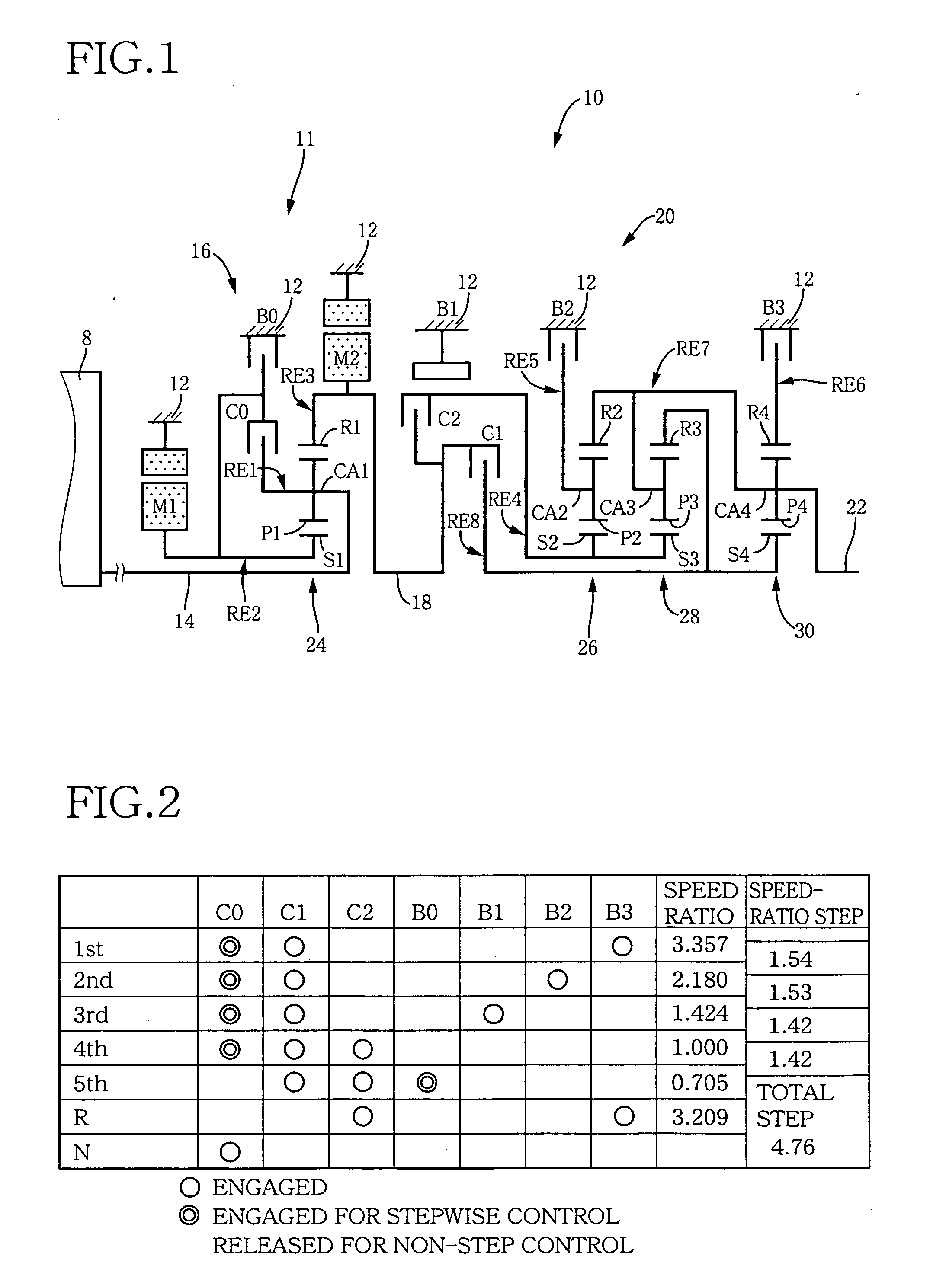Control apparatus for use with driving device of vehicle
a control apparatus and driving device technology, applied in the direction of brake systems, instruments, gearing, etc., can solve the problems of no power transmission device that has the respective advantages, and the driving device as a whole cannot help occupying a large space, so as to achieve high fuel consumption rate, improve fuel consumption rate, and achieve high transmission efficiency
- Summary
- Abstract
- Description
- Claims
- Application Information
AI Technical Summary
Benefits of technology
Problems solved by technology
Method used
Image
Examples
first embodiment
[0044]FIG. 1 is a schematic view for explaining a transmission system 10 constituting a portion of a driving device of a so-called “hybrid” automotive vehicle to which the present invention is applied. The hybrid vehicle additionally includes an electronic control device 40 shown in FIG. 4. In FIG. 1, the transmission system 10 includes an input shaft 14 as a rotary input member, a non-step (i.e., continuous) speed change portion 11 as a power transmission device, an automatic speed change portion 20 as a stepwise automatic transmission, and an output shaft 22 as a rotary output member all of which are provided, in series, on a common axis in a transmission case 12 (hereinafter referred to as the “case 12”) as a non-rotary (i.e., stationary) member that is fixed to a body of the vehicle. The non-step speed change portion 11 is connected to the input shaft 14 directly, but it may be connected indirectly via, e.g., a pulsation absorbing damper (i.e., a vibration damping device), not s...
second embodiment
[0105]FIG. 11 is a schematic view for explaining a transmission system 70 constituting a portion of another driving device to which the present invention is applied; FIG. 12 is an operation table representing a relationship between speed steps of the transmission system 70 and corresponding combinations of respective operating states of hydraulically operated frictional coupling devices; and FIG. 13 is a collinear chart for explaining speed change operations of the transmission system 70.
[0106] Like the transmission system 10 employed in the first embodiment, the transmission system 70 employed in the present, second embodiment includes the non-step (i.e., continuous) speed change portion 11 including the first electric motor M1, the power transfer 16, and the second electric motor M2. In addition, the transmission system 70 includes an automatic speed change portion 72 that is provided between the non-step speed change portion 11 and the output shaft 22, is connected, in series, t...
third embodiment
[0114]FIG. 14 shows a seesaw-type switch 44 (hereinafter, simply referred to as the switch 44) as a portion of a speed change state manual selector that is manually operable by a driver for selectively switching the power transfer 16 to the differential state or to the non-differential state, i.e., the transmission system 10, 70 to the non-step speed change state or the stepwise speed change state. The switch 44 may be provided, in each of the above-described first and second embodiments, in the hybrid vehicle such that the switch 44 is manually operable by the driver. This switch 44 enables the driver to run the vehicle in a desired or selected one of the different speed change control modes. The switch 44 includes a first portion that is labeled “STEP” and corresponds to the stepwise speed change control mode, and a second portion that is labeled “NON-STEP” and corresponds to the non-step speed change control mode. When the driver pushes the first or second portion of the switch 4...
PUM
 Login to View More
Login to View More Abstract
Description
Claims
Application Information
 Login to View More
Login to View More - R&D
- Intellectual Property
- Life Sciences
- Materials
- Tech Scout
- Unparalleled Data Quality
- Higher Quality Content
- 60% Fewer Hallucinations
Browse by: Latest US Patents, China's latest patents, Technical Efficacy Thesaurus, Application Domain, Technology Topic, Popular Technical Reports.
© 2025 PatSnap. All rights reserved.Legal|Privacy policy|Modern Slavery Act Transparency Statement|Sitemap|About US| Contact US: help@patsnap.com



